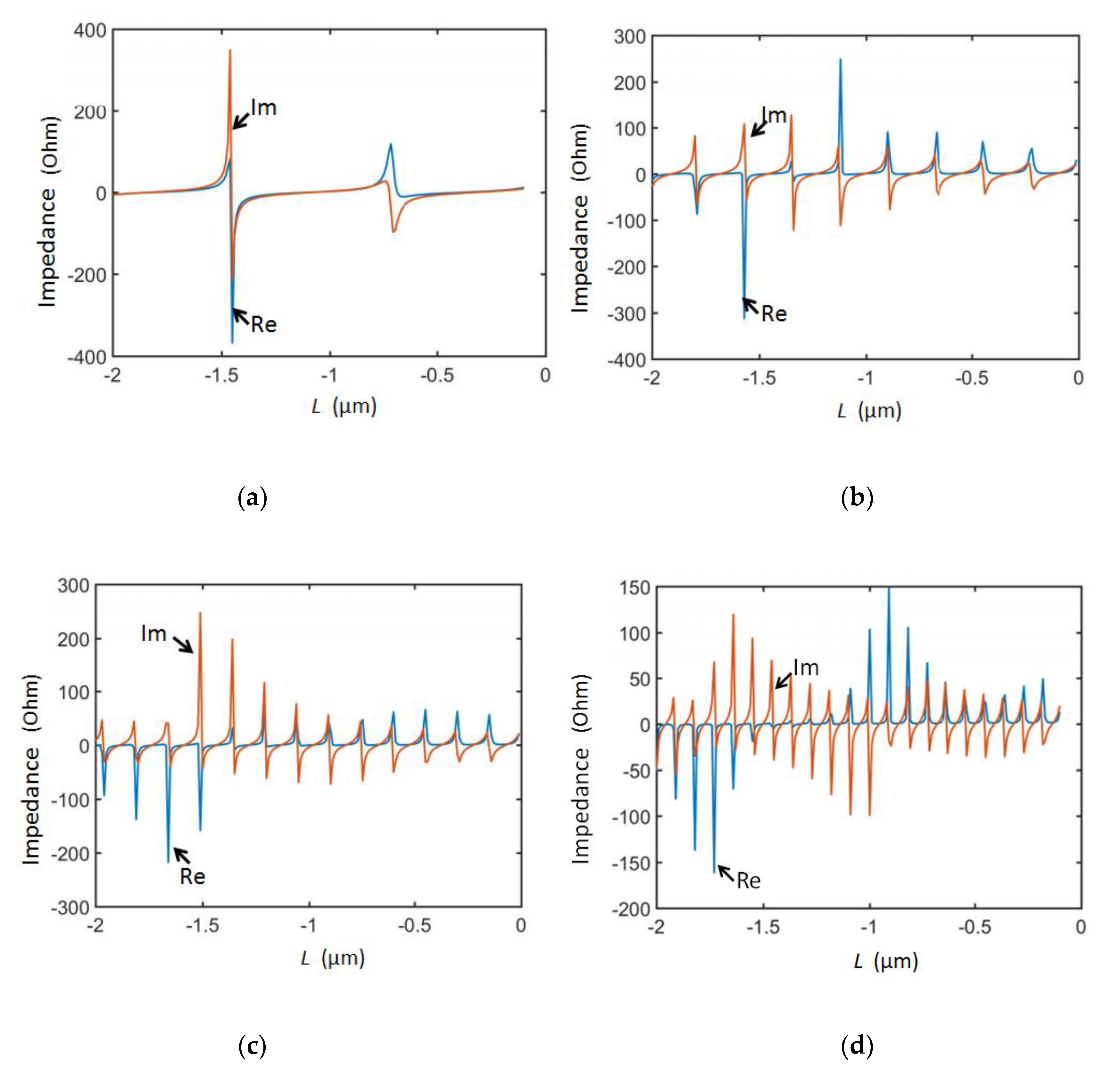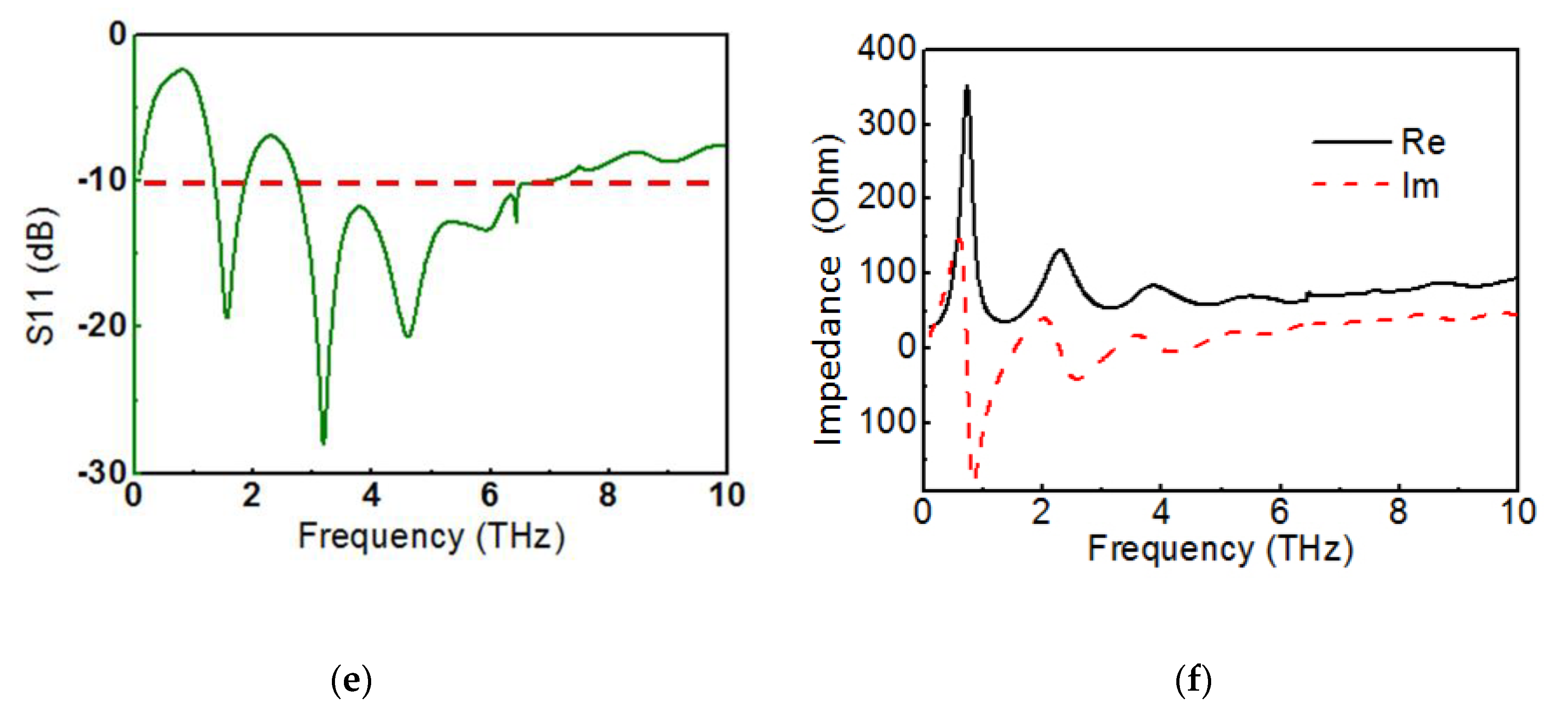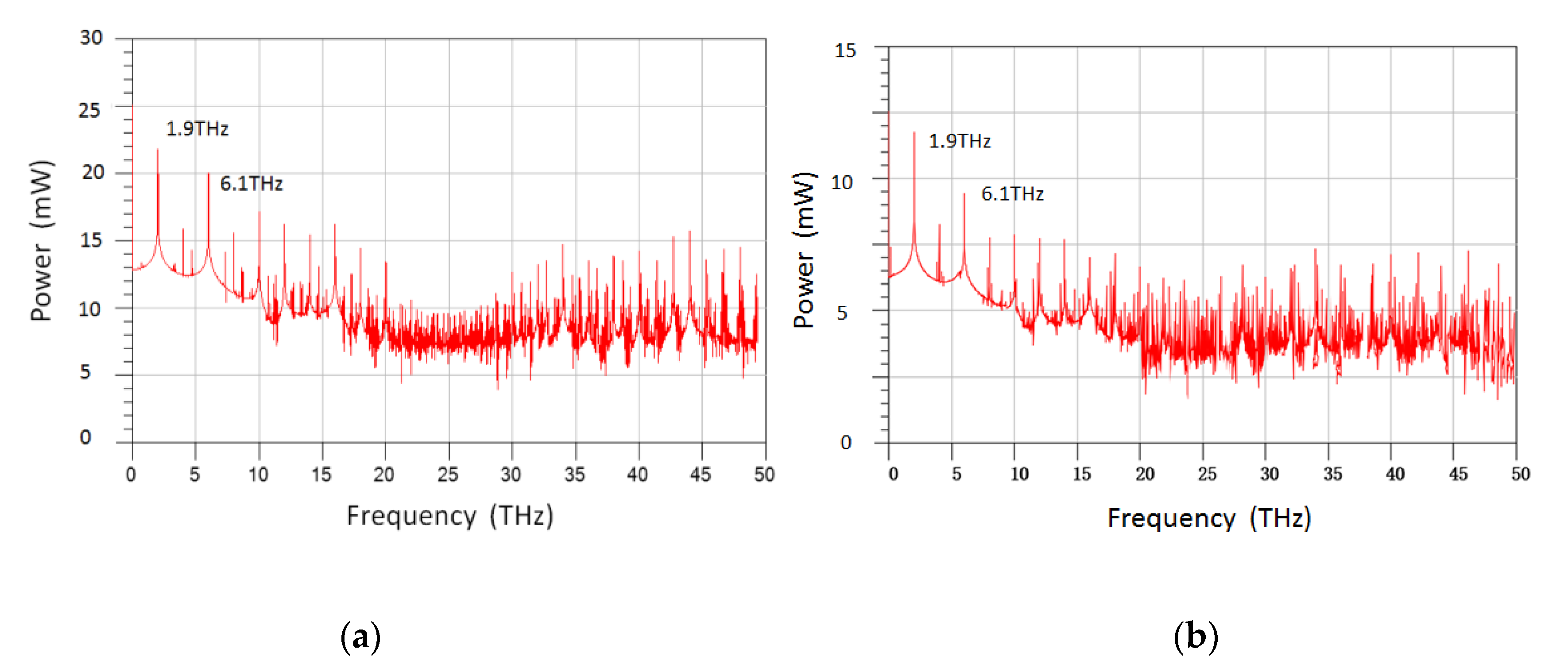Resonant Tunneling Diode (RTD) Terahertz Active Transmission Line Oscillator with Graphene-Plasma Wave and Two Graphene Antennas
Abstract
:1. Introduction
2. Modeling
3. Simulation and Discussion
4. Conclusions
Author Contributions
Funding
Conflicts of Interest
References
- Choe, W.; Jeong, J. A Broadband THz On-Chip Transition Using a Dipole Antenna with Integrated Balun. Electronics 2018, 7, 236. [Google Scholar] [CrossRef]
- Kanaya, H.; Sogabe, R.; Maekawa, T.; Suzuki, S.; Asada, M. Fundamental Oscillation up to 1.42 THz in Resonant Tunneling Diodes by Optimized Collector Spacer Thickness. J. Infrared Millim. Terahertz Waves 2014, 35, 425–431. [Google Scholar] [CrossRef]
- Izumi, R.; Suzuki, S.; Asada, M. 1.98 THz resonant-tunneling-diode oscillator with reduced conduction loss by thick antenna electrode. In Proceedings of the IEEE 2017 42nd International Conference on Infrared, Millimeter, and Terahertz Waves (IRMMW-THz), Cancun, Mexico, 27 August–1 September 2017; pp. 1–2. [Google Scholar] [CrossRef]
- Orihashi, N.; Hattori, S.; Suzuki, S.; Asada, M. Experimental and Theoretical Characteristics of Sub-Terahertz and Terahertz Oscillations of Resonant Tunneling Diodes Integrated with Slot Antennas. Jpn. J. Appl. Phys. 2005, 44, 7809–7815. [Google Scholar] [CrossRef]
- Li, C.H.; Chiu, T.Y. 340-GHz Low-Cost and High-Gain On-Chip Higher Order Mode Dielectric Resonator Antenna for THz Applications. IEEE Trans. Terahertz Sci. Technol. 2017, 7, 284–294. [Google Scholar] [CrossRef]
- TeraView, TeraPulse Lx. Available online: http://www.teraview.com/products/TeraPulse%204000/index.html (accessed on 13 September 2019).
- TOPTICA Photonics, Terahertz Systems Optoelectronic Terahertz-Generation. Available online: https://www.toptica.com/products/terahertz-systems/ (accessed on 13 September 2019).
- Wasige, E.; Alharbi, K.H.; Alkhalidi, A.; Wang, J.; Khalid, A.; Rodrigues, G.C.; Figueiredo, J. Resonant tunnelling diode terahertz sources for broadband wireless communications. In Terahertz, RF, Millimeter, and Submillimeter-Wave Technology and Applications X; Society of Photo-optical Instrumentation Engineers: Bellingham, WA, USA, 2017; p. 101031J. [Google Scholar] [CrossRef]
- Oshima, N.; Hashimoto, K.; Horikawa, D.; Suzuki, S.; Asada, M. Wireless data transmission of 30 Gbps at a 500-GHz range using resonant-tunneling-diode terahertz oscillator. In Proceedings of the 2016 IEEE MTT-S International Microwave Symposium (IMS), San Francisco, CA, USA, 22–27 May 2016; pp. 1–4. [Google Scholar] [CrossRef]
- Maekawa, T.; Kanaya, H.; Suzuki, S.; Asada, M. Frequency increase in terahertz oscillation of resonant tunnelling diode up to 1.55 THz by reduced slot-antenna length. Electron. Lett. 2014, 50, 1214–1216. [Google Scholar] [CrossRef]
- Asada, M.; Suzuki, S.; Kishimoto, N. Resonant tunneling diodes for sub-terahertz and terahertz oscillators. Jpn. J. Appl. Phys. 2008, 47, 4375. [Google Scholar] [CrossRef]
- Pozar, D.M. Microwave Engineering, 4 ed.; Wiley: Hoboken, NJ, USA, 2012; pp. 1–48. [Google Scholar]
- Burke, P.J.; Spielman, I.B.; Eisenstein, J.P.; Pfeiffer, L.N.; West, K.W. High frequency conductivity of the high-mobility two-dimensional electron gas. Appl. Phys. Lett. 2000, 76, 745–747. [Google Scholar] [CrossRef]
- Sensale-Rodriguez, B.; Lei, L.; Fay, P.; Jena, D.; Xing, H.G. Power amplification at THz via plasma wave excitation in RTD-gated HEMTs. IEEE Trans. Terahertz Sci. Technol. 2013, 3, 200–206. [Google Scholar] [CrossRef]
- Sensale-Rodriguez, B. Graphene-insulator-graphene active plasmonic terahertz devices. Appl. Phys. Lett. 2013, 103, 123109. [Google Scholar] [CrossRef] [Green Version]
- Mao, X.; Xie, S.; Zhu, C.; Geng, Z.; Chen, H. Theoretical study of terahertz active transmission line oscillator based on RTD-gated HEMT. AIP Adv. 2018, 8, 065323. [Google Scholar] [CrossRef]
- Zhu, C.; Mao, L.; Zhao, F.; Mao, X.; Guo, W. Photo-Controlled Terahertz Amplified Modulator via Plasma Wave Excitation in ORTD-gated HEMTs. IEEE Photonics J. 2017, 9, 1–8. [Google Scholar] [CrossRef]
- Chen, J.; Badioli, M.; Alonso-González, P.; Thongrattanasiri, S.; Huth, F.; Osmond, J.; Spasenović, M.; Centeno, A.; Pesquera, A.; Godignon, P. Optical nano-imaging of gate-tunable graphene plasmons. Nature 2012, 487, 77. [Google Scholar] [CrossRef] [PubMed]
- Fei, Z.; Rodin, A.S.; Andreev, G.O.; Bao, W. Gate-tuning of graphene plasmons revealed by infrared nano-imaging. Nature 2012, 487, 82. [Google Scholar] [CrossRef] [PubMed]
- Thongrattanasiri, S.; Manjavacas, A.; de Abajo, F.J.G. Quantum Finite-Size Effects in Graphene Plasmons. ACS Nano 2012, 6, 1766–1775. [Google Scholar] [CrossRef] [Green Version]
- Cox, J.D.; Silveiro, I.; de Abajo, F.J.G. Quantum Effects in the Nonlinear Response of Graphene Plasmons. ACS Nano 2016, 10, 1995–2003. [Google Scholar] [CrossRef] [Green Version]
- Dasgupta, S.; Nidhi, Brown, D.F.; Wu, F.; Keller, S.; Speck, J.S.; Mishra, U.K. Ultralow nonalloyed Ohmic contact resistance to self aligned N-polar GaN high electron mobility transistors by In(Ga)N regrowth. Appl. Phys. Lett. 2010, 96, 3. [Google Scholar] [CrossRef]
- Green, A.J.; Gillespie, J.K.; Fitch, R.C.; Walker, D.E.; Lindquist, M.; Crespo, A.; Brooks, D.; Beam, E.; Xie, A.; Kumar, V.; et al. ScAlN/GaN High-Electron-Mobility Transistors With 2.4-A/mm Current Density and 0.67-S/mm Transconductance. IEEE Electron Device Lett. 2019, 40, 1056–1059. [Google Scholar] [CrossRef]
- Wang, R.H.; Saunier, P.; Xing, X.; Lian, C.X.; Gao, X.A.; Guo, S.P.; Snider, G.; Fay, P.; Jena, D.; Xing, H.L. Gate-Recessed Enhancement-Mode InAlN/AlN/GaN HEMTs With 1.9-A/mm Drain Current Density and 800-mS/mm Transconductance. IEEE Electron Device Lett. 2010, 31, 1383–1385. [Google Scholar] [CrossRef]
- Guo, J.; Li, G.; Faria, F.; Cao, Y.; Wang, R.; Verma, J.; Gao, X.; Guo, S.; Beam, E.; Ketterson, A.; et al. MBE-Regrown Ohmics in InAlN HEMTs With a Regrowth Interface Resistance of 0.05 Omega mm. IEEE Electron Device Lett. 2012, 33, 525–527. [Google Scholar] [CrossRef]
- Wang, J.; Al-Khalidi, A.; Zhang, W.; Wasige, E.; Kelly, A.E.; Watson, S.; Cantu, H.; Figueiredo, J. Resonant tunneling diode oscillators for optical communications. In Third International Conference on Applications of Optics and Photonics; International Society for Optics and Photonics: Bellingham, WA, USA, 2017. [Google Scholar] [CrossRef] [Green Version]
- Cong, J.; Mao, L.; Xie, S.; Zhao, F.; Yan, D.; Guo, W. Photoelectric Dual Control Negative Differential Resistance Device Fabricated by Standard CMOS Process. IEEE Photonics J. 2019, 11. [Google Scholar] [CrossRef]
- Yang, C.C. Influence of Parasitic Effects in Negative Differential Resistance Characteristics of Resonant Tunneling. Electronics 2019, 8, 673. [Google Scholar] [CrossRef]
- Shanawani, M.; Masotti, D.; Costanzo, A. THz Rectennas and Their Design Rules. Electronics 2017, 6, 99. [Google Scholar] [CrossRef]
- Suzuki, S.; Shiraishi, M.; Shibayama, H.; Asada, M. High-Power Operation of Terahertz Oscillators with Resonant Tunneling Diodes Using Impedance-Matched Antennas and Array Configuration. IEEE J. Sel. Top. Quantum Electron. 2013, 19, 8500108. [Google Scholar] [CrossRef]
- Suzuki, S.; Teranishi, A.; Hinata, K.; Asada, M. Fundamental oscillation up to 831 GHz in GaInAs/AlAs resonant tunneling diode. In Proceedings of the 2009 IEEE International Conference on Indium Phosphide & Related Materials, Newport Beach, CA, USA, 10–14 May 2009. [Google Scholar] [CrossRef]






© 2019 by the authors. Licensee MDPI, Basel, Switzerland. This article is an open access article distributed under the terms and conditions of the Creative Commons Attribution (CC BY) license (http://creativecommons.org/licenses/by/4.0/).
Share and Cite
Zhao, F.; Zhu, C.; Guo, W.; Cong, J.; Tee, C.A.T.H.; Song, L.; Zheng, Y. Resonant Tunneling Diode (RTD) Terahertz Active Transmission Line Oscillator with Graphene-Plasma Wave and Two Graphene Antennas. Electronics 2019, 8, 1164. https://doi.org/10.3390/electronics8101164
Zhao F, Zhu C, Guo W, Cong J, Tee CATH, Song L, Zheng Y. Resonant Tunneling Diode (RTD) Terahertz Active Transmission Line Oscillator with Graphene-Plasma Wave and Two Graphene Antennas. Electronics. 2019; 8(10):1164. https://doi.org/10.3390/electronics8101164
Chicago/Turabian StyleZhao, Fan, Changju Zhu, Weilian Guo, Jia Cong, Clarence Augustine T. H. Tee, Le Song, and Yelong Zheng. 2019. "Resonant Tunneling Diode (RTD) Terahertz Active Transmission Line Oscillator with Graphene-Plasma Wave and Two Graphene Antennas" Electronics 8, no. 10: 1164. https://doi.org/10.3390/electronics8101164





